L4- The Global Food System
Globalisation of the food system:
Came about by:
migration of crops from where they originated to new locations (by people)
trade in crops between locations of production and consumption (was previously focused on high value items but is all foods now)
Process of globalisation in history has been mediated by:
migration of people
trade
expansion of empires
New archaeological evidence shows…
agriculture began independently in lots of different places from 12,000 ya:

different places have distinct cultures with different crops:
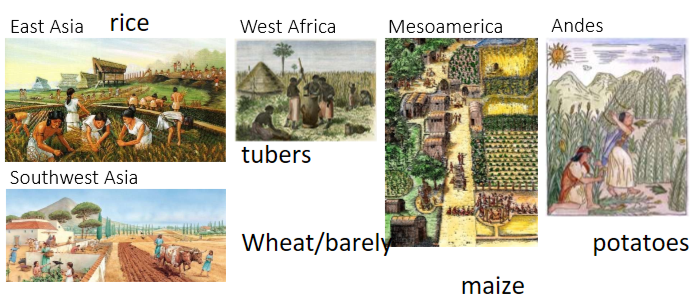
e.g. Middle Eastern Fertile Crescent→ 12,000ya, where agriculture spread around Europe reaching the UK, grain crops, founded on these species:
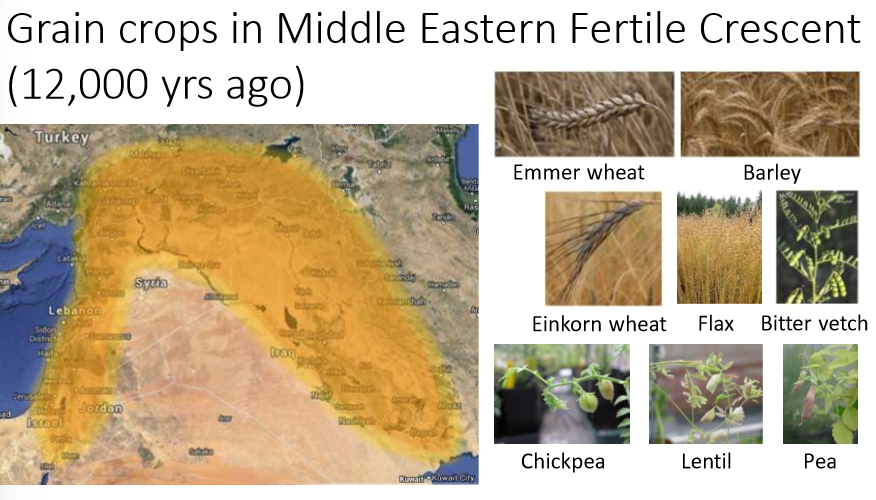
e.g. New Guinea→ 10,000ya, vegetable crops rather than seed crops, veggies propagated using asexual reproduction culture:
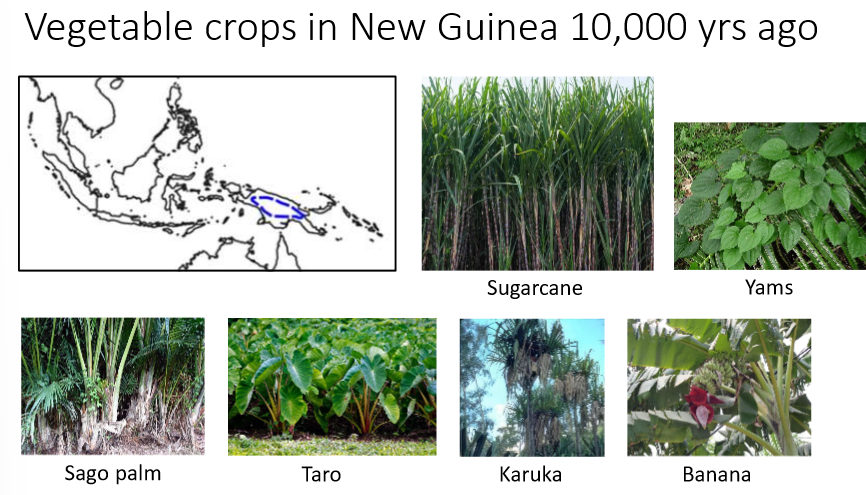
people moved crops/products long distances thousands of years ago
e.g. East-West exchange in Eurasia→ wheat from the fertile crescent reached China along Silk Road trade routes
e.g. Pearl millet and sorghum from Africa reached India along Sabean Way trade routes
Trade routes:
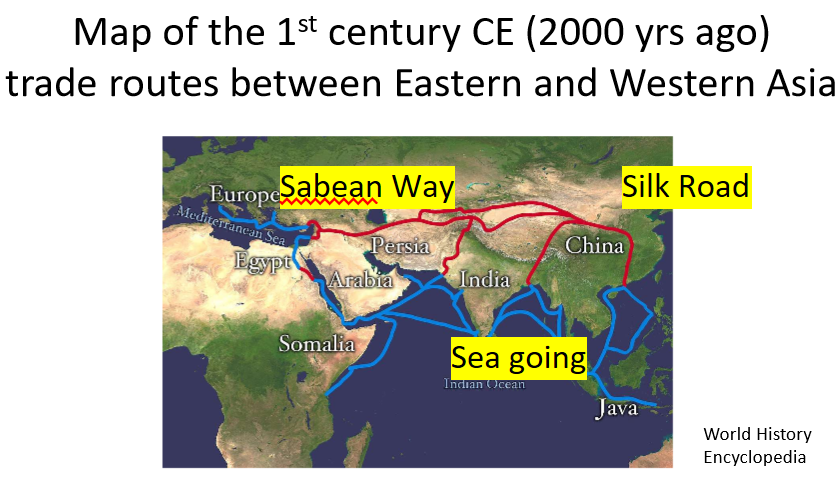
empires played important roles in this:
e.g. Aztec in the Americas moving maize
Islamic empires supported trade in sugar cane from SE Asia, sorghum from Africa, citrus fruits, bananas, aubergine and watermelon from the West, all into in 650-1258AD
european colonisation of the Americas→
e.g. Columbian exchange- sugarcane from SE Asia, moved into West Europe by Islamic empires, moved into the Americas by Europeans from late 1400s→ Atlantic Slave Triangle
e.g. maize, cassava, peanut, sweet potatoes and potatoes are considered African cuisine but were all taken from the Americas in 1500s into Africa
→ there has been a big exchange of species around the world since the 1500s
Why were some crops adopted and others weren’t?
e.g. sweet potato- South American crop, arrived in the Philippines by Spanish colonisers, adopted quickly→ already had a veggie culture
e.g. wheat- Spanish colonisers wanted it grown in the Philippines for their catholic mass ceremonies but was not adopted→ difficult to grow and used different techniques
→ similarity in crops is an important factor for the crop being adopted
Trade:
long-distance trade used to centre around high value luxuries→ was hard to obtain, were collected by high status individuals e.g. Asian spices (10000 BCE- 1500 CE)
as European colonisation progressed, prices came down:
new trade routes
increase in technology
cost of labour reduced due to use of slaves
traded goods were more accessible to all Europeans in the modern era
trade became even cheaper in the 20th century→ reduction of tariffs on goods promoted international trade, part of great acceleration after WW2
e.g. North American Free Trade Agreement in 1994 made trade easier between the US and its neighbours
the most efficient way to produce food is for each country to focus on what they can do well, to sell on the international market:
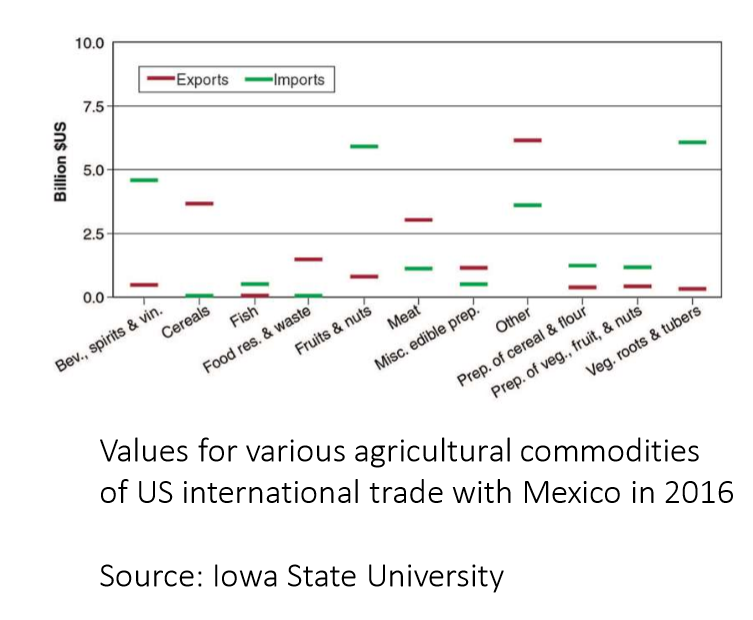
has led to regional diversification but global homogenisation of crops:
there are >7,000 edible plant species but 90% of global supply of plant calories comes from 15 species, 60% only from rice, wheat, sugar and maize
there are 15,000 bird/mammal species but global supply of animal protein comes only from 3 species- chicken, pork and beef
this is significant as crop diversity and irrigation are considered the most important factors stabilising year across year-to-year variation:

risk of low crop diversity:
limits resilience to climate extremes
increases vulnerability to pests/pathogens
restricts access to micronutrients
e.g. banana clone was replaced by Cavendish banana- grown at Chatsworth house
Embodied land footprint in international crops:
environmental damage caused by the food system is on an international level
more than 50% of EU consumption takes place in other countries e.g. 23% Argentinian cropland, 20% Brazilian cropland→ impacts happening outside of borders
Summary:
Long history of ancient crop migrations and trade that have increased in recent centuries and decades→ free trade agreements
Modern crop production is more diverse in each region than it was in the past, but it has become globally homogenized.
International trade in crop products means that the land footprints and environmental damage associated with agriculture are “exported” to consumers in the same way as CO2 emissions.
Industrialisation of Agricultural Production:
Industrialisation on the food system means:
mechanisation→ reduces labour
synthetic chemical inputs→ fertilisers, pesticides
Industrialisation led to…
decline in importance of agriculture as an employer:
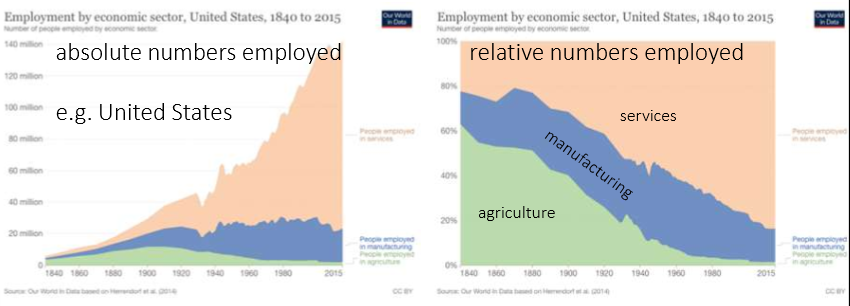
→ seen in lots of Western industrialised countries
share of GDP is decreasing but GDP of agriculture is increasing→ becoming more productive:
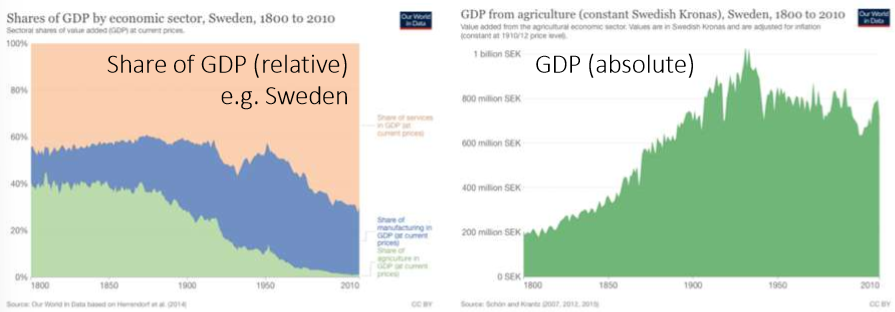
due to mechanisation, use of chemical inputs, green revolution→ publically funded breeding programs focusing on particular crops (maize, wheat) in the late 20th century to increase yields, made them widely adopted across Asia and Latin America, other crops are being considered for this now e.g. cassava
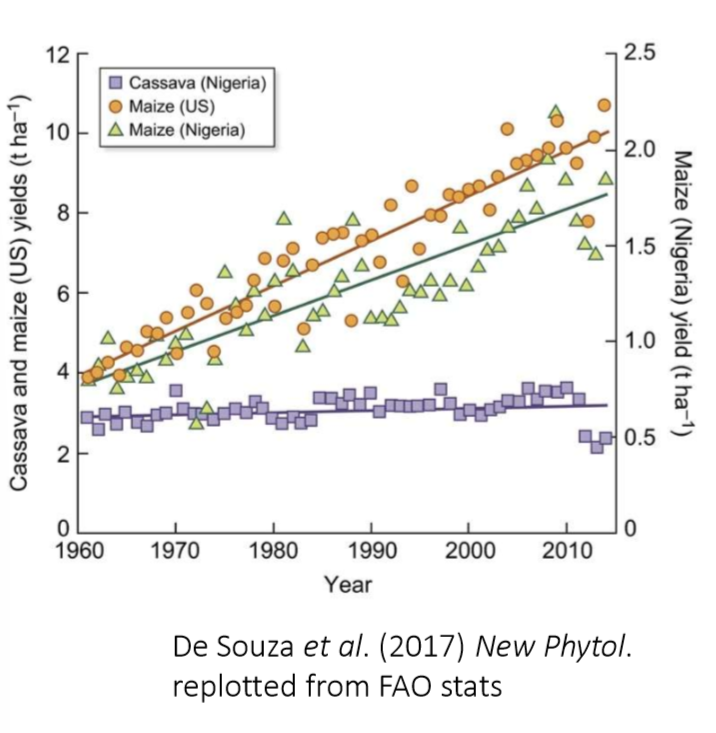
BLOG POST ON SLIDES
Industrialisation of meat production:
is more efficient to rear animals indoors these days
has less GHG emissions→ largely determined by how long animals live and quality of diets
issues→ animal welfare, high water use, high excreta pollution, antibiotic resistance
Summary:
Mechanisation, chemical inputs and modern varieties have improved crop yields and economic production relative to labour inputs→ 7x increase in production, but comes at an environmental and nutrition cost
Concentrated animal operations have done the same for livestock.
Modern food system impacts on climate and health:
Nutrition transition:
increase in consumption in processed foods globally in recent decades
associated with urbanisation→ change diets as moving into cities
as GDP increases, there is more consumption of meat, oils, sugar and calories
HIC eat more empty calories- meat, oil, calories without nutritional values
but there are exceptions e.g. China- cultural differences, and India- meat doesn’t increase due to cultural reasons
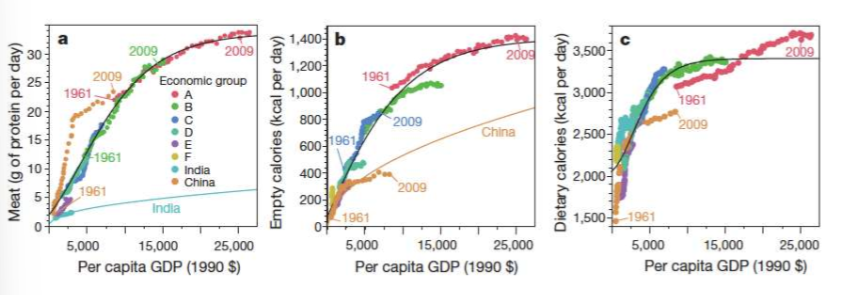
→ cannot apply solutions globally due to important cultural differences
How has the nutritional transition happened?
globalisation of agricultural goods through production and trade
foreign investment in food processing and marketing through multinational companies
high income groups benefit from more choice, low income groups have poorer diets as these products are cheaper
Issues with the nutritional transition:
1.9b people overweight, risk of heart disease, stroke, diabetes, cancers, causes more deaths than undernutrition
people and our livestock dominate mammal biomass, seen similarly in domesticated birds:
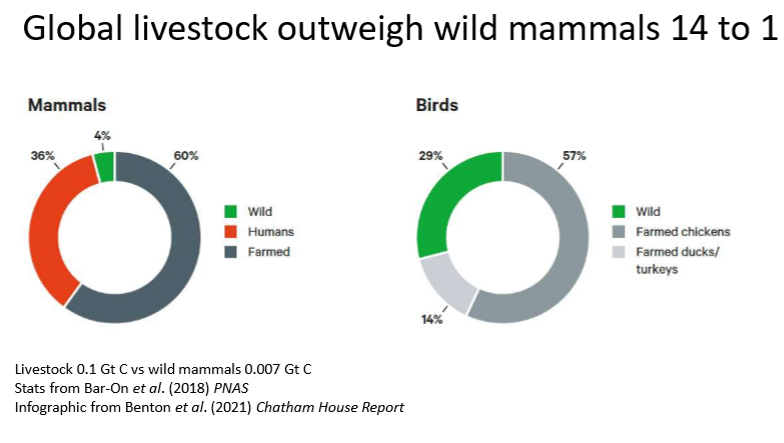
40% of edible human crops are fed to livestock:

only a small amount of soya is directly consumed by humans, most is consumed by livestock- poultry and pigs:
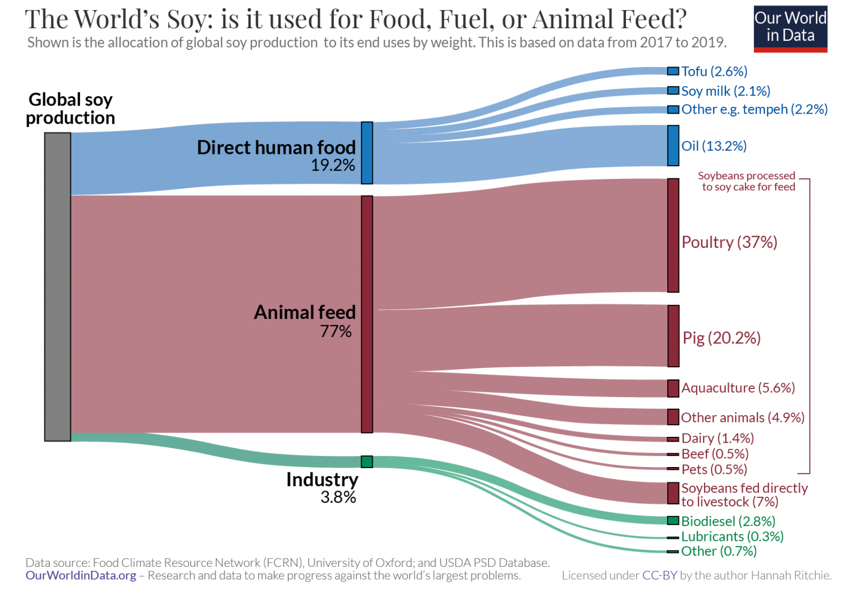
fraction of cereal production differs depending on world, larger in western countries and brics (brzail, russia, chinaA (not India and south africa this time):
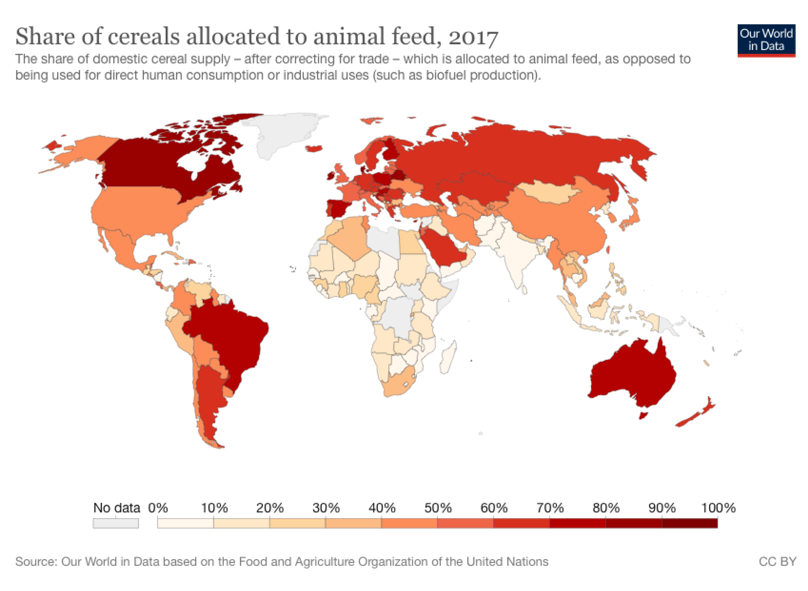
food system is associated with large GHG emissions→ large fractions of this comes from meat production through land clearance on farms
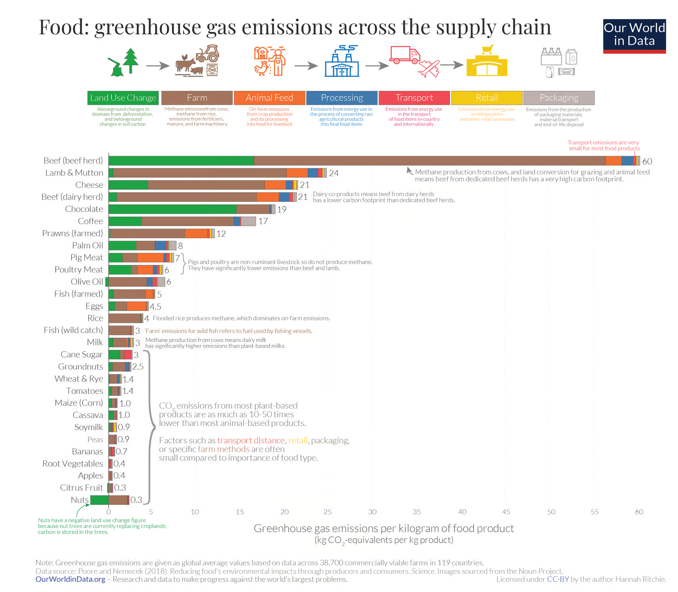
1/3 from deforestation
¼ from methane production
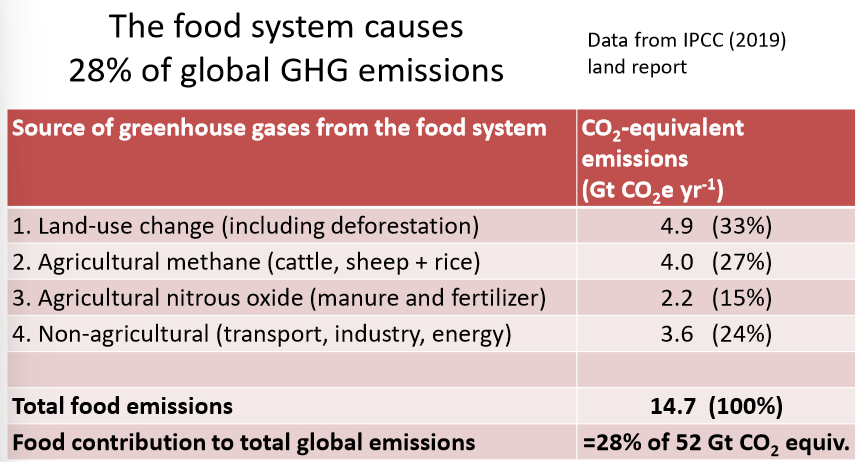
increasing global demand for animal products means future projections show increases in GHG emissions from this:
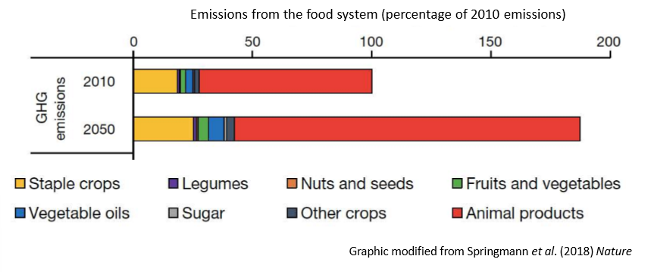
future food production will take up future CO2 budgets:
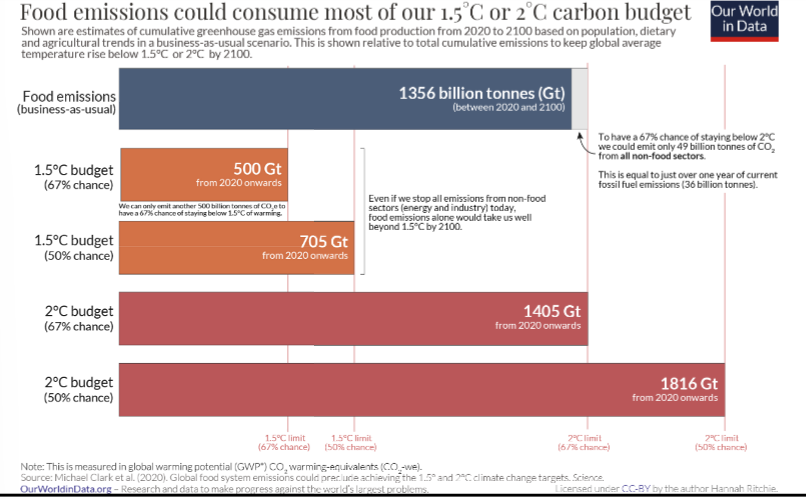
Summary:
Globalised food consumption is causing a nutrition transition towards overeating and processed foods.
The nutrition transition is negatively impacting global health (rising obesity, diabetes, cardiovascular disease, cancers).
Global demand for meat accounts for a major fraction of crop production, land use and agricultural greenhouse gas emissions.
→ Globalisation of the food system has raised agricultural production and efficiency at the expense of health and the environment.